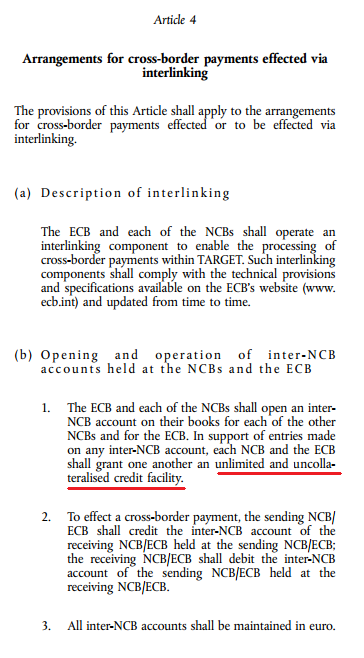In exchange rate agreements and arrangements such as the ERM I and II, central banks would risk running out of foreign reserves in case of a speculative attack on the currency. They may commit to each other on defending the exchange rate but in extreme cases, the agreements may lose their significance.
When I saw first this guideline on the ECB Website on TARGET (on NCBs and the ECB providing unlimited and uncollateralized credit facility to each other) – a couple of years back – I was a bit shocked but later seemed to make sense:
In return, the Euro Area member nations had to irrevocably lock in exchange rates as per this nice article on TARGET by Peter Garber in 1998: Notes On The Role Of TARGET In A Stage III Crisis (h/t Tom Hickey). Garber also has another interesting article (a special report from Deutsche Bank) The Mechanics Of Intra Euro Capital Flight, December 2010.
According to Garber in the previously existing Very Short Term Financing Facility (VSTFF), central bank of the nation seeing private inflows theoretically has to provide unlimited credit to the central bank of the nation seeing private outflows.
The VSTFF is a facility to be used if serious intervention is necessary to preserve official bilateral bands in the Exchange Rate Mechanism. Under the Basle-Nyborg agreement, the weak currency central bank is to intervene in the exchange markets to prevent the exchange rate from breaching the band. The strong currency central bank is responsible for providing credit to the weak currency central bank through the VSTFF, theoretically in unlimited amounts but in fact limited by the effect on the strong currency central bank’s monetary policy.
More in the paper. Of course, Garber is incorrect in assuming that the central bank providing credit loses control of its monetary policy. (Expect a future post on Sterilization). Anyway interesting paper – especially on how capital flight from the “periphery” before a breakup can lead to huge losses for the creditor Euro Area nations.
